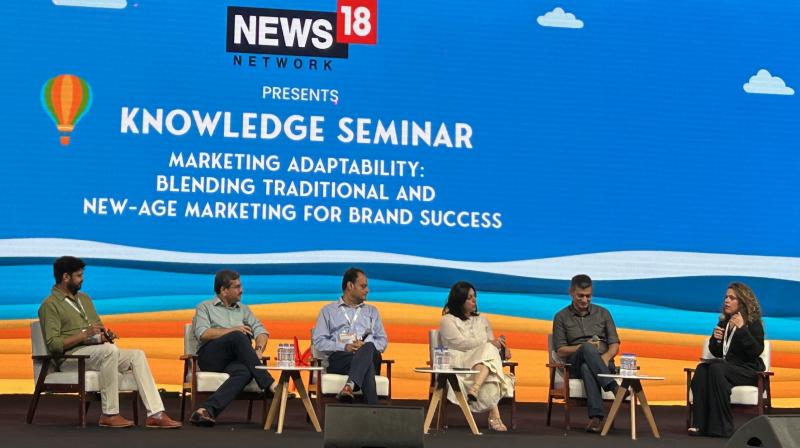Adaptability is the key in today’s fast-paced marketing landscape, where marketers must constantly evolve to stay ahead of the curve.
To address the importance of reformation in marketing strategies, day two of Goafest wrapped up with a panel comprising Chandan Mukherjee, director and executive vice president, Nestle; Shubhranshu Singh, chief marketing officer, Tata Motors Commercial Vehicles; Sukhleen Aneja, chief executive officer, The Good Glamm Group; Sandeep Karwa, vice president, monetisation, Flipkart; and Zairus Master, chief business officer, Honasa Consumer, stressing the need for a balanced approach of the old and new methods to achieve marketing goals effectively.
The session was moderated by Delshad Irani, editor, Storyboard 18.
Integrate traditional and new-age marketing strategies
In his opening remarks, Singh emphasised the critical role of innovation and creativity in marketing. "The distinction between traditional and online marketing, despite its apparent stability in recent days and likely continuity tomorrow, is continually evolving. Adapting to this evolution is challenging because, as humans, we are not naturally programmed for adaptability. Historically, those who investigated a shaking bush often became prey, leaving behind a gene pool that fled from danger. This has conditioned us to stick to what works, repeat successful actions, and resist change. Hierarchical organisations, where leaders have long relied on established methods, are particularly resistant to rapid change, as it positions the change advocate as a disruptor."
Singh continued by addressing the comfort found in routine. "Building muscle, for example, requires repeatedly tearing and lifting beyond one’s limits. This principle applies to marketing as well. Relying on the same person to perform the same task leads to efficiency but stagnation, much like being on a treadmill—lots of activity without real progress."
Reflecting on his early days in marketing, Hindustan Unilever in 1999, Singh noted the vastly different landscape.
"It was a time of cosy arrangements with fewer competitors for audience attention, and market dominance could be bought. The real transformation today is not just the digital tools we have but the digital lifestyles of consumers. This shift necessitates that marketers and management genuinely value consumers’ lives," he said.
Karwa elaborated on the ongoing evolution of e-commerce, highlighting the rise of big commerce and its impact on traditional methods.
"We're witnessing a significant transformation, which is creating a new norm," Karwa observed.
"This rapid change is fascinating. Looking back five years, some traditional hierarchies and management designs were hindering innovation and adaptation. Now, we're seeing a shift. Brands that were discussing strategies with us last quarter have already changed their approach. They're asking, 'What can we do differently?," he asked.
Karwa shared a recent example to illustrate this shift. "Recently, a brand approached us with an innovative idea. They wanted to place a banner on our app that, when clicked, would create a CGI effect making the screen appear to crack. This shows how brands are now thinking creatively, pushing the boundaries of what can be done on platforms like Flipkart. Instead of relying on established tools and requesting payment for their use, brands are coming up with unique ideas and asking how we can implement them."
Karwa also discussed the blending of traditional and new-age marketing methods, which he believes fosters creativity. "For example, even today, many advertisers use billboards, but they also ensure their campaigns go viral on digital platforms. This blend of traditional and digital marketing is where innovation truly happens."
Focus on brand-building
Master highlighted the significance of ‘brand building’ for the long-term sustainability of any marketing organisation.
"We understand that the enduring success of any marketing endeavour hinges on the strength of the brand. Brands need to employ various media and tools in this pursuit. However, in today's fast-paced environment, we don't have the luxury of time. The lifespan of strategies is constantly shrinking, necessitating swift action. We have an array of tools at our disposal, leveraging advancements like data analytics and computing power. Yet, amidst all this, it's crucial to recognise that every action we undertake, whether it's utilising search metrics or employing traditional forms of marketing, ultimately contributes to the same objective: brand creation and business growth," Master expressed.
Rules for resource allocation
Mukherjee discussed the changing dynamics of marketing funnels, contrasting the classical approach with today's seamless transitions. "Today, the funnel is seamless. It can move from one level to another fairly quickly. A cohesive strategy is important, stressing the integration of various marketing channels. Depending on the goal, a marketer can use a mix of different things and seamlessly integrate if there is a big picture in mind," he explained.
However, Mukherjee acknowledged the challenges of resource allocation in this dynamic environment. He shared, “While there are tools to understand resource allocation, sometimes the pace of change surpasses what measurement can capture.”
Can marketers keep up with the pace of change?
Aneja reflected on the challenge of keeping pace with the rapid changes in business dynamics.
"We all fundamentally love growth and want to sell products. But as consumers ourselves, we understand the necessity of adaptation to avoid becoming redundant. Traditional companies are not inherently traditional; they are simply more reliant on offline distribution channels. The democratisation of distribution is a significant factor enabling business expansion. The online business has democratised distribution, allowing for more flexible strategies and market expansion," she explained.
She delved into the contrasting approaches between online and offline business models, emphasising the importance of adaptation and innovation to meet consumer demands. Aneja shared, "While online platforms prioritise convenience and quick delivery, offline models focus on depth of consumption and market relevance. Innovation is key to relevance and success, regardless of the business model. The dynamic nature of the market must evolve to meet consumer needs.”
Will AI be disruptive for marketers?
Singh cautioned against a superficial understanding of AI and the tendency to be swayed by sensationalist narratives.
"Our grasp of AI is, at best, superficial; we need a more nuanced approach. The marketing industry tends to prematurely declare the demise of traditional media like TV and print. The 'next big thing' often seems monumental at first glance, sparking a frenzy of activity across various sectors. However, with time, the true impact of these phenomena emerges, revealing a lasting transformation that alters our societal norms and practices,” Singh pointed out.
Karwa expressed that at the heart of it all, the advancements in AI, especially in data processing capabilities, are reshaping our industry and beyond.
"We're witnessing an evolution in job roles, with tasks becoming more substantial and dynamic. Consider the depth of data processing achievable by today's machines. We stand on the brink of delivering personalised experiences at an unprecedented scale. Picture this: every user opening the Flipkart app encounters content tailored precisely to their preferences—colours, calls to action, and more—all dynamically generated. What was once manual and time-consuming is now within grasp, promising unmatched levels of efficiency and customisation. This transformation isn't merely noteworthy; it's revolutionary, unlocking opportunities we couldn't fathom before. That's the true magnitude of its impact," Karwa shared.
Digital penetration in India
Master believes that the pace of change is remarkable in India, particularly in digitisation. He said, “In India, the digital landscape has expanded rapidly, with over 600 million people now connected—surpassing the reach of other media forms. However, amidst this rapid change, we mustn't overlook the value of tradition. Tradition grounds us in where we are, while the future beckons us forward. As a company, we navigate this balance by leveraging both traditional and modern approaches based on our objectives. It's not about pitting tradition against adaptability; rather, it's about embracing progress seamlessly. Let's break down the barriers between modern and traditional, recognising that they coexist and complement each other."
Mukherjee pointed out that India's diversity defies a singular narrative; it's a mosaic of cultures, languages, and social dynamics.
He remarked, “Success hinges on adaptability, the ability to craft tailored solutions and deploy diverse strategies. From introducing coffee to tea-centric towns to blending classical methods with aspirational approaches, the essence lies in integrating these elements to address specific goals. In navigating the evolving landscape, the importance of understanding the role of creators and influencers is not about discarding the old for the new but about integrating various elements to navigate change. AI emerges as a crucial enabler, handling the deluge of data with finesse. While technology plays a pivotal role, human creativity remains paramount, guiding AI's application across content creation and media strategies.”
Sharing her closing remarks, Aneja said, “Collective adaptation is crucial for growth, whether in business or our work methods. It's imperative to acknowledge that the pace of change will perpetually outpace human evolution. By remaining humble, committed to continuous learning, and deploying new insights, we can ensure our relevance. Human intelligence will always trump artificial intelligence when coupled with humility and a readiness to evolve alongside technological advancements."












